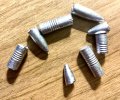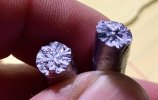You are using an out of date browser. It may not display this or other websites correctly.
You should upgrade or use an alternative browser.
You should upgrade or use an alternative browser.
I "broke" a couple bullets yesterday...
- Thread starter CWLONGSHOT
- Start date
Bliksem
Active Member
Still too hot when dropping them from the mold. Rich alloy won’t help as it makes this more likely, been there & done that.
The trouble is when you fracture a bullet and it comes apart when lubing and you realize your whole cast batch needs to be redone. The lightbulb went on as at a previous range session I had a few weird events when 2 dust clouds were raised on the ground before the targets. Bullets must have broken during firing.
The trouble is when you fracture a bullet and it comes apart when lubing and you realize your whole cast batch needs to be redone. The lightbulb went on as at a previous range session I had a few weird events when 2 dust clouds were raised on the ground before the targets. Bullets must have broken during firing.
358156 hp
At large, whereabouts unknown.
I once cast pistol bullets from a mystery "linotype" that I later decided was probably babbitt. They cast well, and I water dropped them as well. I wanted really hard bullets and I got them. I cast them for a 40 S&W, and 45 acp. I sized and lubed them, and loaded them with a pretty solid taper crimp. I remember hearing a little creaking sound when I taper crimped them, but thought nothing of it at the time. As the bullets fed into the pistol, I often felt something hit my hand ever so lightly. The bullet holes in paper targets were perfectly round, and recoil seemed lighter than other loads I'd worked up with these bullets. I wrote it off to the bullets being lighter because of the alloy. I was wrong.
It turned out that the bullet noses were most likely fracturing as I taper crimped them. The feeling of something hitting my hand was actually the bullet nose coming off the bullet in the feeding cycle and being launched out of the pistol, and some of them would hit my hand during reentry. I've often joked about inventing the discarding bullet nose wadcutter for semi-auto pistols. I discovered the truth when I accidentally dropped a round while loading and the nose fell off.
You could simply let your bullets cool in the mould a few seconds longer, then drop them into deeper cold water to harden. You have a nice large crystalline structure showing, and I suspect you probably have a higher antimony content in that alloy than you're expecting.
It turned out that the bullet noses were most likely fracturing as I taper crimped them. The feeling of something hitting my hand was actually the bullet nose coming off the bullet in the feeding cycle and being launched out of the pistol, and some of them would hit my hand during reentry. I've often joked about inventing the discarding bullet nose wadcutter for semi-auto pistols. I discovered the truth when I accidentally dropped a round while loading and the nose fell off.
You could simply let your bullets cool in the mould a few seconds longer, then drop them into deeper cold water to harden. You have a nice large crystalline structure showing, and I suspect you probably have a higher antimony content in that alloy than you're expecting.
CWLONGSHOT
Well-Known Member
I had maybe 40 bullets in the bucket when this happened. I picked out a few and added about a gal of water and looked them over and no more found.
Thanks guys it about what I thought so Im learning!!
OOH, as I said just a few cast when I found. I also had the pot on high!! I set it there and allow melt, then turn back before I start ta cast. Well I forgot.
This is my RF Range alloy with lino as hardener. 1# lino to 10# tin rich lead.
CW
Thanks guys it about what I thought so Im learning!!
OOH, as I said just a few cast when I found. I also had the pot on high!! I set it there and allow melt, then turn back before I start ta cast. Well I forgot.
This is my RF Range alloy with lino as hardener. 1# lino to 10# tin rich lead.
CW
Ssssssssllllllllooooowwwww dddooooowwwwwnnnn
Hot moulds with the right alloy are very prone to this.
Yes and turn down the pot temp. Anything over 700 for an Sb alloy causes it's own problems. As you have experienced.
Bret4207
At the casting bench in the sky. RIP Bret.
I once cast pistol bullets from a mystery "linotype" that I later decided was probably babbitt. They cast well, and I water dropped them as well. I wanted really hard bullets and I got them. I cast them for a 40 S&W, and 45 acp. I sized and lubed them, and loaded them with a pretty solid taper crimp. I remember hearing a little creaking sound when I taper crimped them, but thought nothing of it at the time. As the bullets fed into the pistol, I often felt something hit my hand ever so lightly. The bullet holes in paper targets were perfectly round, and recoil seemed lighter than other loads I'd worked up with these bullets. I wrote it off to the bullets being lighter because of the alloy. I was wrong.
It turned out that the bullet noses were most likely fracturing as I taper crimped them. The feeling of something hitting my hand was actually the bullet nose coming off the bullet in the feeding cycle and being launched out of the pistol, and some of them would hit my hand during reentry. I've often joked about inventing the discarding bullet nose wadcutter for semi-auto pistols. I discovered the truth when I accidentally dropped a round while loading and the nose fell off.
You could simply let your bullets cool in the mould a few seconds longer, then drop them into deeper cold water to harden. You have a nice large crystalline structure showing, and I suspect you probably have a higher antimony content in that alloy than you're expecting.
YUPPER!!! Did the same thing with some 30 or 314 200-ish gr jobs some years back. Kept hearing that little "tink" sound as I crimped the super hard WQ bullets. I was using slower powers and trying to get Warp 9 speeds and wanted a clean burn and at that time I was convinced I needed a good solid crimp. I had pieces hitting the paper, didn't make the connection and finally had one nose break away as I tried to chamber a round.
Lesson learned- harder isn't always better!


